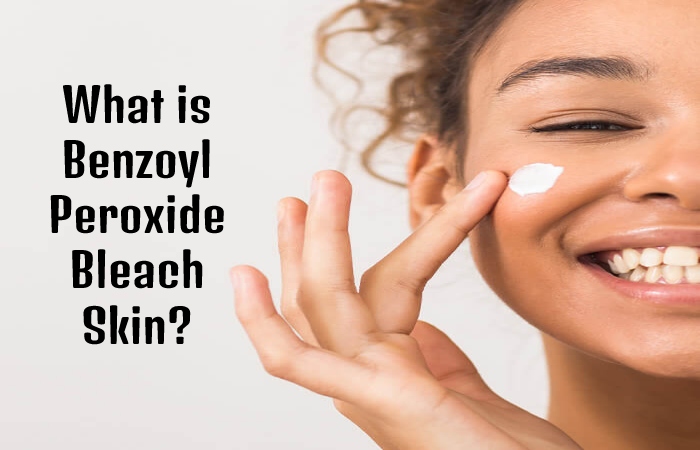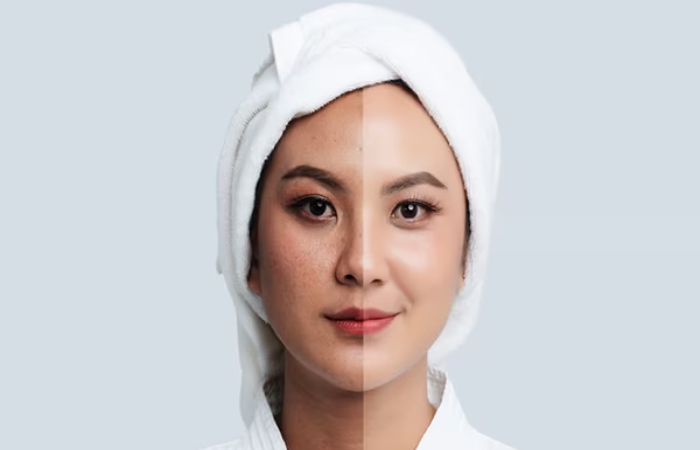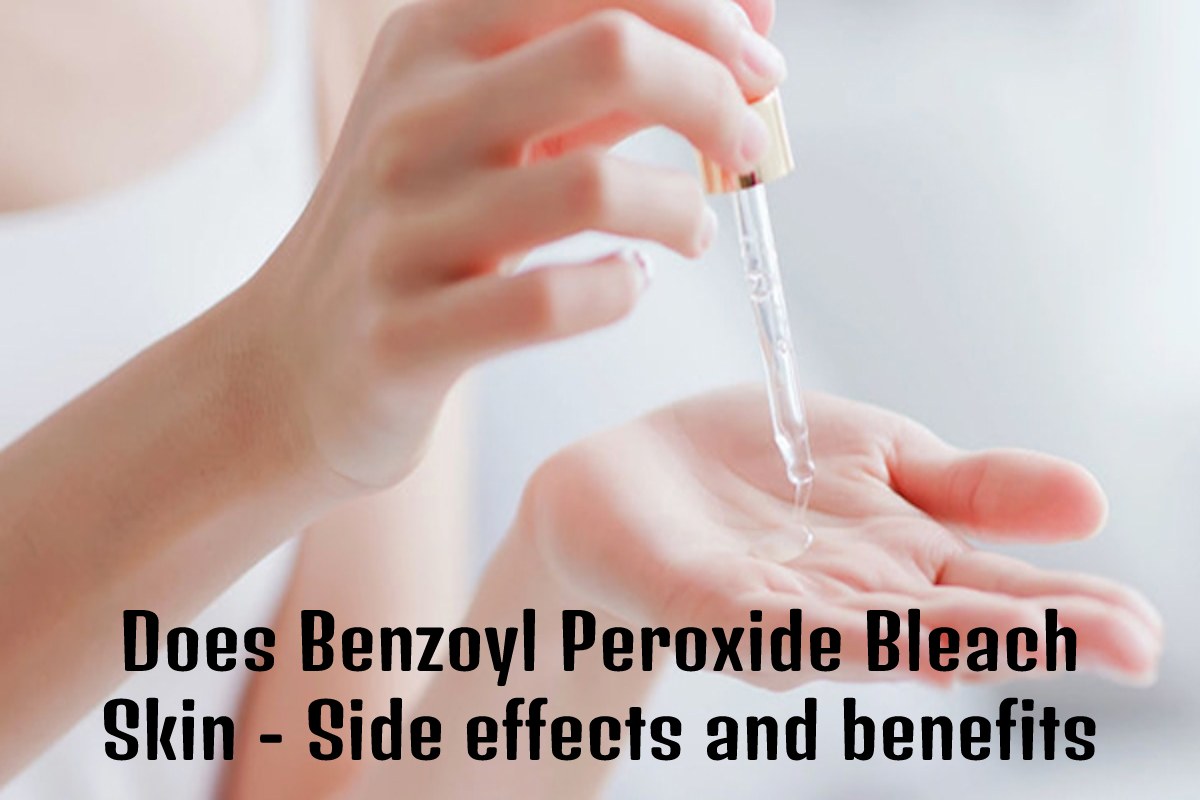Table of Contents
Introduction
Does Benzoyl Peroxide Bleach Skin: If you’ve ever had skin problems, you must have annoyed enough treatments by now. But, there is one substance that skin care professionals rely on for its effectiveness against a wide range of skin conditions: benzoyl peroxide.
Benzoyl peroxide has antibacterial properties and might be an exciting cure for acne. It exists on prescription, over-the-counter, or in ordinary cleansers and other skin care products. People can find benzoyl peroxide in numerous skin care products, gels, creams, and face washes.
Benzoyl peroxide is a whitening agent and can turn the skin whiter. While using topical benzoyl peroxide, you may notice your skin turning one shade lighter after lengthy use. For this cause, benzoyl peroxide is not recommended for scalp acne, as it can go the hair white.
People can catch benzoyl peroxide in over-the-counter (OTC) topical treatments or lower concentrations in supermarket products like body and face washes. Benzoyl peroxide also has lightning properties. Let’s find out why it’s good for the skin, its side effects, and how to use it.
What is Benzoyl Peroxide Bleach Skin?

Benzoyl peroxide bleach skin is an antibacterial that kills bacteria on the skin’s surface. It is an organic peroxide with an oxidizing effect, meaning it can release oxygen into the skin to execute germs.
The structure of benzoyl peroxide bleach skin is parallel to hydrogen peroxide, commonly used to treat cuts and wounds. In addition to its antimicrobial properties, benzoyl peroxide is anti-inflammatory and can unclog pores on the skin.
Benzoyl Peroxide used for skin
Acne
Benzoyl peroxide is a topical acne medication, and it is found in cleansers, lotions, gels, creams, and toners. It’s an OTC (over-the-counter) treatment, but it’s also available by prescription.
Over-the-counter benzoyl peroxide treatment works well for mild acne, while prescription-strength benzoyl peroxide works for modest acne. It is one of the lively ingredients in many prescription acne combination treatments like BenzaClin, Benzamycin, Acanya, Duac, Epiduo, etc.
Benzoyl Peroxide for Dark Spots or Scars
Inflammatory acne, such as papules, pustules, nodules, and cystic acne, leaves scars or dark spots on the skin. As much as you resist the urge to pick at them, it’s common to see dark spots or scars after acne.
Some skin care experts have found that benzoyl peroxide can remove dead skin cells and reduce the appearance of dark spots or scars. However, the function of benzoyl peroxide as an exfoliant has not been scientifically proven.
Benzoyl Peroxide for Warts
Warts are slight, flat, or round bumps that appear on the face, legs, and backs of hands. Benzoyl peroxide is prescribed for warts because it can irritate the skin and cause the skin to peel, resulting in the wart being removed. Your dermatologist will usually recommend 5% benzoyl peroxide, which is available as an over-the-counter treatment.
Benzoyl Peroxide for the Scalp
Hair care products can be a reason for scalp breakouts. Scalp acne can be treated with benzoyl peroxide for its antibacterial and decongesting properties. The downside of benzoyl peroxide for the scalp is that it can bleach your hair.
Benzoyl Peroxide for Boils
Bacteria and inflamed follicles cause boils. It can treat spots because it can topically kill pathogenic bacteria.
Benzoyl Peroxide for Rosacea
Benzoyl peroxide can be used to delight rosacea but is not FDA approved for rosacea treatment. Rosacea is a skin ailment that causes visible blood vessels in the skin. Benzoyl peroxide can irritate the skin in patients with rosacea. Therefore, consult your dermatologist before starting treatment.
Benzoyl Peroxide for Skin Lightening

Benzoyl peroxide is a lightening agent and can whiten skin. When using topical benzoyl peroxide, you may find that your skin becomes slightly lighter after prolonged use. For this reason, benzoyl peroxide is not recommended for scalp acne as it can turn hair white.
Can Benzoyl Peroxide be used for Milia?
Milia, or milk spots, are spots full of keratin that look on the face. Benzoyl peroxide is not an actual treatment for milia.
How is Benzoyl Peroxide used on the face?
Benzoyl peroxide can be used in concentrations of 2.5 – 10%.
Note: Consult your doctor before consuming benzoyl peroxide if you are pregnant or breastfeeding.
Benzoyl Peroxide Facial Wash and Cleanser
Choose a concentration of around 4% benzoyl peroxide and increase this up to 10%, depending on how well your skin tolerates it.
How to use:
- Wet your face and softly massage the cleanser in circular motions.
- After a minute or two, rinse carefully with water.
- Pat dry with a fresh and soft towel.
Benzoyl Peroxide Acne Ointments, Gels, and Spot Treatments
Select a milder awareness, like 2.5%, and go up to 5%, as these are leave-on products.
How to use:
- Clean your face with a warm cleanser and pat dry.
- Apply benzoyl peroxide cream or gel to the affected areas or all over the face.
- Use the gel or ointment in your morning and evening skincare routine.
Do You Apply Benzoyl Peroxide Over Your Face?
Dermatologists commend using benzoyl peroxide all over the face. This is the only way to eliminate pimples and prevent further acne.
Benzoyl Peroxide Side Effects
Benzoyl peroxide can cause extreme dryness or peel in some people’s skin, sometimes scaly and also rough. Use it minimally for the first week or two and also gradually increase the frequency. Therefore you can follow it up with a good moisturizer.
Slight redness, burning, or itching can also be some side effects of benzoyl peroxide.
Benzoyl peroxide can mark your skin more susceptible to sun damage. It is necessary to use sun cream every day before going outside.
What Bacteria Does Benzoyl Peroxide Kill?
Benzoyl peroxide penetrates the skin to kill the bacterium Propionibacterium acnes (P. acnes). It produces oxygen in the skin, and these bacteria cannot survive in an oxygen-rich environment. After killing the P.acnes bacteria, benzoyl peroxide unblocks pores and keeps them fit.
How Many Times a Day Must You Use Benzoyl Peroxide?
Skin care specialists recommend using benzoyl peroxide once or twice a day. You can start with a concentration of 4% and also work your way up to higher concentrations. If you experience dryness, switch to a weaker formula, e.g., B., with a concentration of 2.5% side-step using benzoyl peroxide in the morning if your skin is highly sunned sensitive.
Does Benzoyl Peroxide Burn the Skin?
Benzoyl peroxide can burn or sting readily for the first few days of treatment, and this is a combined side effect and will go away over time. Your skin may also feel itchy or red, but consult your dermatologist if you notice severe reactions.
How Lengthy Does it Take for the Benzoyl Peroxide to Work?
Wait 8-10 weeks to see a visible change in your skin. Don’t be tempt to apply more benzoyl peroxide to heal your acne faster. Therefore It takes time to fade acne with benzoyl peroxide, just like any other acne treatment.
Suppose you have been a patient on OTC benzoyl peroxide treatment for more than 12 weeks and still haven’t noticed a difference in your acne. In that case, it’s time to visit your dermatologist’s office if your doctor may recommend a different treatment for your acne.
How Much is Benzoyl Peroxide, too much?
Benzoyl peroxide can be use at concentrations ranging from 2.5% to 10%. Please start with the lowest concentration, Hence they can sometimes get rid of acne without drying out the skin. Do not use rinse-off or no-rinse products more than twice a day for 8 to 10 weeks of treatment.
Conclusion
Benzoyl peroxide is an effective current treatment option for acne, and it works to kill bacteria. Some alternative topical treatments such as hydroxy acids, retinoids, and tea tree oil may also help treat acne.
Many topical acne treatments require people to wear broad-spectrum sunscreen and limit their exposure to sunlight. Individuals should follow product directions carefully and consult a dermatologist about possible side effects. Pregnant women should consult a dermatologist to determine which products are safe.

